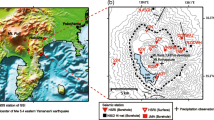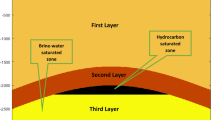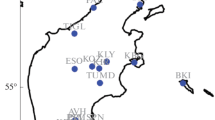Abstract
Based on the barometric data recorded by the seismic monitoring network on the Chinese mainland, Lamb wave periods and relative arrival times of 462 stations are obtained with the aid of Meyer’s wavelet decomposition, Welch’s periodogram spectrum estimation and waveform cross-correlation. By extracting the seismic Rayleigh waves of two seismic stations in the South Pacific and comparing them with the synthetic seismograms, the occurrence time of the first two large volcanic eruptions and the largest volcanic eruption are credibly deduced, and then the travel times and propagation speeds of the Lamb waves are obtained. In order to further explain the attributes of the pressure disturbance associated with the complex acoustic gravity wave (AGW) phases on pressure, a series of numerical simulations with the QSSP program are applied to yield highly similar waves corresponding to the barometric records, which indicates that the eruption source may contain more than 10 sub-events within an hour. According to our detailed analyses, major conclusions are obtained as follows: (1) Although the primary pressure disturbance of the Tonga volcanic eruption appears to be a simple bulge, it is in fact a complex wave composed of multiple eruptions. The largest eruption occurred about 13 min after the first large eruption. (2) In addition to the propagation of the traditional Lamb mode, the Pekeris mode phase that propagates with a lower speed is also observed in some stations, and its amplitude is about a fifth of the Lamb wave. The Pekeris waves may have been more significantly delayed as they traveled against the westerly wind due to their much shorter periods and lower velocities. (3) The group velocity of the Lamb wave is about 308 m/s. Its average period is 70 min, and the wavelength is about 1300 km. The arrival time deviation at each station is negatively correlated with the difference in the near-surface air temperature between North and South China. However, accurately estimating the parameters of the Pekeris waves or the antipodal Lamb waves is challenging due to their low signal-to-noise ratio (SNR), even though the horizontal propagation speed of the Pekeris wave toward China is estimated to be approximately 225 m/s. (4) Much shorter periods and later arrivals at the stations within 200 km of Beijing may be related to the significant cooling (i.e. 12 °C temperature drop), which occurred from Ulantoba, Outer Mongolia, to Beijing beginning at noon on January 15 (Beijing time).












Similar content being viewed by others
Data availability
Data of the 2-day pressure records in the paper available on request from the corresponding author.
References
Ambrosius, B., Scharroo, R., Vigny, C., Schrama, E., & Simons, W. (2005). The 26 December 2004 Sumatra earthquake and tsunami seen by satellite altimeters and GPS. In P. van Oosterom, S. Zlatanova, & E. M. Fendel (Eds.), Geo-information for disaster management. Heidelberg: Springer, Berlin. https://doi.org/10.1007/3-540-27468-5_23
Chatterjee, S., & Hadi, A. S. (1986). Influential observations, high leverage points, and outliers in linear regression. Statistical Science, 1, 379–393.
Chung, M. (2003). Riesz basis of Coifman and Meyer’s local sine and cosine type. Journal of Mathematics and Applications, 285, 456–462.
Cronin, S. J., Brenna, M., Smith, I. E. M., Barker, S. J., Tost, M., Ford, M., Tonga’onevai, S., Kula, T., & Vaiomoung, R. (2017). New volcanic island unveils explosive past. Eos. https://doi.org/10.1029/2017EO076589
Díaz, J. S., & Rigby, S. E. (2022). Energetic output of the 2022 Hunga Tonga-Hunga Ha‘apai volcanic eruption from pressure measurements. Shock Waves, 32, 553–561.
Dolgikh, G., Dolgikh, S., & Ovcharenko, V. (2022). Initiation of infrasonic geosphere waves caused by explosive eruption of Hunga Tonga-Hunga Ha‘apai volcano. Journal of Marine Science and Engineering. https://doi.org/10.3390/jmse1008106
Francis, S. H. (1973). Acoustic-gravity modes and large-scale traveling ionospheric disturbances of a realistic, dissipative atmosphere. Journal of Geophysical Research, 78, 2278–2301. https://doi.org/10.1029/JA078i013p02278
Gohd, C. (2022). Explosive underwater volcano eruption in Tonga spotted from space in satellite images. Retrieved January 15, 2022, from https://www.space.com/tonga-volcano-eruption-satellite-photos
Guo, W. F., Liu, J. Q., Xu, W. G., Li, W., & Lei, M. (2015). Reassessment of the magma system beneath Tianchi volcano, Changbaishan: Phase equilibria constraints. Chinese Science Bulletin, 60, 3489–3500.
Harkrider, D. C. (1964). Theoretical and observed acoustic-gravity waves from explosion sources in the atmosphere. Journal of Geophysical Researchs, 69, 5295–5321.
Hunt, J. N., Palmer, R., & Penney, W. (1960). Atmospheric waves caused by large explosions. Philosophical Transactions of the Royal Society, A252, 275–305.
Jack, W. R. (1987). Air pressure wave from Mount St. Helens eruptions. Journal of Geophysical Research, 92, 11979–11992.
Johnson, J. B., Aster, R. C., & Kyle, P. R. (2004). Volcanic eruptions observed with infrasound. Geophysical Research Letters, 31, L14604. https://doi.org/10.1029/2004GL020020
Jones, R. V. (1962). Sub-acoustic waves from large explosion. Nature, 193, 229–232.
Kanamori, H., & Anderson, D.L. (1977). Importance of physical dispersion in surface wave and free oscillation problems: review. Reviews of Geophysics, 15, 105–112
Kubota, T., Saito, T., & Nishida, K. (2022). Global fast-traveling tsunamis driven by atmospheric Lamb waves on the 2022 Tonga eruption. Science, 377, 91–94.
Kulichkov, S. N., Chunchuzov, I. P., Popov, O. E., et al. (2022). Acoustic-gravity lamb waves from the eruption of the Hunga-Tonga-Hunga-Hapai volcano, its energy release and impact on aerosol concentrations and tsunami. Pure and Appllied Geophysics, 179, 1533–1548.
Le Bras, R. J., Zampolli, M., Metz, D., Haralabus, G., Bittner, P., Villarroel, M., Matsumoto, H., Graham, G., & Meral Özel, N. (2022). The Hunga Tonga–Hunga Ha’apai Eruption of 15 January 2022: Observations on the International Monitoring System (IMS) Hydroacoustic Stations and Synergy with Seismic and Infrasound Sensors. Seismological Research Letters. https://doi.org/10.1785/0220220240
Lewis B. (2022). Complete 1976 Standard Atmosphere (https://www.mathworks.com/matlabcentral/fileexchange/13635-complete-1976-standard-atmosphere), MATLAB Central File Exchange. Retrieved June 23, 2022.
Li, M., Jiang, J. W., & Wang, X. (2018). Shock wave propagation characteristics of double layer charge explosion in the air. Explosion and Shock Waves, 38, 367–372. In Chinese with English abstract.
Liu, C., Wang, Y. Q., & Bian, J. C. (2010). Applicability evaluation of NCEP/NCAR reanalysis temperature, geopotential height and wind field data in the upper troposphere and lower stratosphere. Meteorogical and Environmental Research, 1, 45–53.
Liu, S. Q., Zhu, Y. Q., Liang, M. J., & Dong, F. F. (2012). Impact of potential tsunami induced by Okinawa trough earthquakes on southeastern seaboard of China. Acta Seismologica Sinica, 34, 283–295. In Chinese with English abstract.
Matoza, R. S., Fee, D., Assink, J. D., et al. (2022). Atmospheric waves and global seismoacoustic observations of the January 2022 Hunga eruption, Tonga. Science, 377, 95–100.
Mcbirney, A. R. (1990). An historical note on the origin of calderas. Journal of Volcanology and Geothermal Research, 42, 303–306.
McNutt, S. R., Thompson, G., West, M. E., Fee, D., Stihler, S., & Clark, E. (2013). Local seismic and infrasound observations of the 2009 explosive eruptions of Redoubt Volcano, Alaska. Journal of Volcanology and Geothermal Research, 259, 63–76.
NASA. (2022). Hunga Tonga-Hunga Ha’apai Erupts. Updated on 19 Jan 2022, from https://earthobservatory.nasa.gov/images/149347/hunga-tonga-hunga-haapai-erupts
NOAA. (1976). U.S. Standard atmosphere 1976.
O’Callaghan, J. (2022). Burst of underwater explosions powered Tonga volcano eruption. Nature (NEWS). https://doi.org/10.1038/d41586-022-01544-y
Pekeris C.L. (1939). The propagation of a pulse in the atmosphere. Proceedings of the Royal Society of London. Series A, Mathematical and Physical Sciences, 171, 434–449. https://doi.org/10.1098/rspa.1939.0076
Pierce, A. D., & Posey, J. W. (1971). Theory of the excitation and propagation of lamb’s atmospheric edge mode from nuclear explosions. Journal of the Royal Astronomical Society, 26, 341–368.
Poli, P., & Shapiro, N. (2022). Rapid characterization of large volcanic eruptions: Measuring the impulse of the Hunga Tonga explosion from teleseismic waves. Geophysical Research Letters, 49, e2022GL098123. https://doi.org/10.1029/2022GL098123
Shi, W. (2022). Affected by the eruption of Tonga submarine volcano, the maximum tsunami amplitude of Shipu Station is about 20 cm. QianJiang Evening NEWS. Retrieved January 17, 2022, from http://k.sina.com.cn/article_1700720163_655eee230200134j7.html.
Vergoz, J., Hupe, P., Listowski, C., Pichon, A. L., Garcés, M. A., Marchetti, E., Labazuy, P., Ceranna, L., Pilger, C., Gaebler, P., Näsholm, S. P., Brissaud, Q., Poli, P., Shapiro, N., DeNegri, R., & Mialle, P. (2022). IMS observations of infrasound and acoustic-gravity waves produced by the January 2022 volcanic eruption of Hunga, Tonga: A global analysis. Earth and Planetary Science Letters, 591, 11639. https://doi.org/10.31905/D808B830
Wang, Y. (2022). Tonga Volcano Eruption: With a power comparable to 1000 Hiroshima atomic bombs, the shock wave has arrived in Hong Kong. Retrieved January 17, 2022, from https://world.huanqiu.com/article/46RD6bbHCV7.
Wang, R. J. (1999). A simple orthonormalization method for stable and efficient computation of Green’s function. Bulletin of the Seismological Society of America, 89, 733–741.
Wang, R. J., Heimann, S., Zhang, Y., Wang, H., & Dahm, T. (2017). Complete synthetic seismograms based on a spherical self-gravitating Earth model with an atmosphere–ocean–mantle–core structure. Geophysical Journal International, 210, 1739–1764.
Watanabe, S., Hamilton, K., Sakazaki, T., & Nakano, M. (2022). First detection of the Pekeris internal global atmospheric resonance: Evidence from the 2022 Tonga Eruption and from Global Reanalysis Data. Journal of the Atmospheric Sciences, 79, 3027–3043.
Wei, H. Q. (2010). Magma up-moving process with the magma prism beneath the Changbaishan volcanoes. Earth Science Frontiers, 17, 11–23. In Chinese with English abstract.
Welch, P. D. (1967). The use of fast Fourier transform for the estimation of power spectra: A method based on time averaging over short, modified periodograms. IEEE Transactions on Audio and Electroacoustics, 15, 70–73.
Wexler, H., & Hass, W. A. (1962). Global atmospheric effects of the October 30, 1961 explosion. Journal of Geophysical Research, 67, 3875–3887.
Wright, C. J., Hindley, N. P., Alexander, M. J., et al. (2022). Surface-to-space atmospheric waves from Hunga Tonga-Hunga Ha’apai eruption. Nature, 609, 741–746.
Yuen, D. A., Scruggs, M. A., Spera, F. J., Zheng, Y., Hu, H., McNutt, S. R., Thompson, G., Mandli, K., Keller, B. R., Wei, S. S., Peng, Z., Zhou, Z., Mulargia, F., & Tanioka, Y. (2022). Under the surface: Pressure-induced planetary-scale waves, volcanic lightning, and gaseous clouds caused by the submarine eruption of Hunga Tonga-Hunga Ha’apai volcano. Earthquake Research Advances, 2, 1–13. https://doi.org/10.1016/j.eqrea.2022.100134
Zhang, S. R., Kong, Y., & Wang, G. H. (2014). Comparative analysis on propagation characteristics of shock wave induced by underwater and air explosions. Journal of Vibration and Shock, 33, 148–153. In Chinese with English abstract.
Acknowledgements
The authors express special thanks to the China Earthquake Networks Center, CEA for providing all barometric data at the seismic stations on the Chinese mainland. During the writing process of this paper, Professor Liang Jianhong of the China Seismic Network Center provided substantial assistance for us. Ms. Murphy from University of Virginia helped us improve the readability of this paper. Additionally, we would like to show our sincere appreciation to the reviewers providing us with many valuable suggestions and references to improve the original manuscript. Finally, we would like to thank Professor Wang Rongjiang for providing us with the refined programs of seismic wave simulation in 2017.
Funding
The authors declare that there is no funding for supporting our research or achievement of our manuscript.
Author information
Authors and Affiliations
Contributions
SL takes full responsibility for this manuscript, including data processing, establishing mathematical model, numerical simulation, drawing the figures, and designing and writing the manuscript. YX is responsible for the logical examination and refining to the manuscript. SC provides the most of barometric data, and contact relevant staffs working at seismic stations to confirm the reliability of the data. HY accomplishes some data preprocessing and rechecks a series of results produced by a batch process with computer. DJ provides a part of barometric data and supplements the new observation data required by the revised draft. YW and YL accomplish the verification of the previous manuscript and point out some defective drawings, and provide some valuable suggestions.
Corresponding author
Ethics declarations
Conflict of interest
There is no conflict of interest in our manuscript.
Additional information
Publisher's Note
Springer Nature remains neutral with regard to jurisdictional claims in published maps and institutional affiliations.
Appendix 1
Appendix 1
See Figs.
13,
Example of extracting the period using the Welch periodogram. The original data of Station Linxikuang have been processed by the baseline offset correction (BOC). Due to the sliding window algorithm, the time of sub-graph (a) has been moved forward by approximately 100 min; the band-pass frequency of extracted data is 2.604e−4–0.0083 Hz
14,
15,
16,
17,
Comparison between the amplitude of Lamb wave and the background pressure at each station; red spots correspond to the stations encircled in Fig. 12
18.
1.1 The Main Parameters for Input of the QSEIS Program
Source depth: 0.0–0.2
Receiver_depth: 0.0sw_equidistant/sw_d_unit: 1/0
Start and end trace distance: 6.808 7.482t_start/twindow/no_t_samples: −50.0 1200.0 2048sw_t_reduce/t_reduce:0/6.0sw_algorithm: 1sw_cut_off: 0.0 0.005 0.32 0.35
Accuracy: 4supp_factor: 0.10issurf: 0sw_path_fliter/shallow_depth_limit: 0/400.0no_of_depth_ranges:0wavelet_duration/sw_wavelet: 25.0 (45.0)/1
Mxx/Myy/Mzz/Mxy/Myz/Mzx: 0.15e+18/0.15e+18/0.15e+18/0/0/0 (First Source)
0.63e+18/0.63e+18/0.63e+18/0/0/0 (Second Source)sw_flat_earth_transform: 1vp_res/vs_res/ro_res: 0.25/0.25/0.5
Layered Earth Model is based on IASP91 and physical dispersion according to Kanamori and Anderson (1977), but the shallower depths above the 71 km are modified slightly as follows:
#Multilayered model parameters (source site)
No. | Depth [km] | vp [km/s] | vs [km/s] | ro [g/cm3] | qp | qs |
|---|---|---|---|---|---|---|
1 | 0.00 | 4.800 | 2.360 | 2.600 | 1752.1 | 778.7 |
2 | 3.00 | 5.800 | 3.360 | 2.600 | 1752.1 | 778.7 |
3 | 20.00 | 5.800 | 3.360 | 2.600 | 1412.2 | 627.6 |
4 | 20.00 | 6.500 | 3.750 | 2.900 | 1412.2 | 627.6 |
5 | 30.00 | 6.500 | 3.750 | 2.900 | 1449.1 | 601.4 |
6 | 30.00 | 8.040 | 4.470 | 3.381 | 1449.1 | 601.4 |
7 | 71.00 | 8.044 | 4.483 | 3.375 | 1464.1 | 607.1 |
1.2 The Main Parameters for Input of the QSSP Program
Uniform receiver depth [km]:0.0–86.0
Time window [s]/sampling interval [s]: 60,000.0/10.0 max.frequency [Hz] of Green’s functions: 0.05 max.slowness [s/km] of Green’s functions: 4.0
Anti-aliasing factor: 0.1
Switch of turning-point filter/the range (d1, d2) of max. penetration depth [km]: 0/2891.5/6371.0
Earth radius [km]/switch of free-surface-reflection filter: 6371.0/1.
The critical frequency [Hz]/the critical harmonic degree: 0.05/500
Selection of spheroidal modes/selection of toroidal modes/minimum/maximum cutoff harmonic degrees: 1/0/100/10000
Number of discrete source depths/estimated radius of each source patch [km]: 1/0.0
List of the source depths [km]/the respective file names of the Green’s functions/the switch number: 0.2 to −3.0/′ME_A_001km′/1
Number of discrete point sources/selection of the source data format:14/1
List of the multi-event sources
M-Unit/Mrr/Mtt/Mpp/Mrt/Mrp/Mtp/Lat/Lon/Depth/T_origin/T_rise |
|---|
0.0311e+19/1.0/1.0/1.0/0.0/0.0/0.0/0.0/0.0/0.2 to −3.0/0.0 /20.0 |
0.0606e+19/1.0/1.0/1.0/0.0/0.0/0.0/0.0/0.0/0.2 to −3.0/200.0/18.0 |
0.0799e+19/1.0/1.0/1.0/0.0/0.0/0.0/0.0/0.0/0.2 to −3.0/280.0/22.0 |
0.0187e+19/1.0/1.0/1.0/0.0/0.0/0.0/0.0/0.0/0.2 to −3.0/340.0/22.0 |
0.1370e+19/1.0/1.0/1.0/0.0/0.0/0.0/0.0/0.0/0.2 to −3.0/560.0/20.0 |
0.1693e+19/1.0/1.0/1.0/0.0/0.0/0.0/0.0/0.0/0.2 to −3.0/620.0/20.0 |
0.1122e+19/1.0/1.0/1.0/0.0/0.0/0.0/0.0/0.0/0.2 to −3.0/680.0/8.0 |
0.0125e+19/1.0/1.0/1.0/0.0/0.0/0.0/0.0/0.0/0.2 to −3.0/840.0/6.0 |
0.1495e+19/1.0/1.0/1.0/0.0/0.0/0.0/0.0/0.0/0.2 to −3.0/940.0/15.0 |
0.1370e+19/1.0/1.0/1.0/0.0/0.0/0.0/0.0/0.0/0.2 to −3.0/1020.0/10.0 |
0.1122e+19/1.0/1.0/1.0/0.0/0.0/0.0/0.0/0.0/0.2 to −3.0/1080.0/6.0 |
0.0747e+19/1.0/1.0/1.0/0.0/0.0/0.0/0.0/0.0/0.2 to −3.0/1900.0/5.0 |
0.0436e+19/1.0/1.0/1.0/0.0/0.0/0.0/0.0/0.0/0.2 to −3.0/2500.0/5.0 |
0.0561e+19/1.0/1.0/1.0/0.0/0.0/0.0/0.0/0.0/0.2 to −3.0/3300.0/4.0 |
Output time window [s]: 60,000.0
Selection of order of Butterworth bandpass filter (if < = 0, then no filtering)/lower/upper corner frequencies:0/0.001/0.130
Lower and upper slowness cutoff [s/km]: 0.0/4.0
The multilayered model parameters:
The solid part is based on Prem_1s_178_without ocean
The atmospheric part is based on US Standard Atmosphere (1976) with the top of 86 km height
Rights and permissions
Springer Nature or its licensor (e.g. a society or other partner) holds exclusive rights to this article under a publishing agreement with the author(s) or other rightsholder(s); author self-archiving of the accepted manuscript version of this article is solely governed by the terms of such publishing agreement and applicable law.
About this article
Cite this article
Liu, S., Xue, Y., Chen, S. et al. Characteristics of Acoustic Gravity Waves from the Tonga Volcano Monitored on the Chinese Mainland on January 15, 2022. Pure Appl. Geophys. 180, 2487–2509 (2023). https://doi.org/10.1007/s00024-023-03307-w
Received:
Revised:
Accepted:
Published:
Issue Date:
DOI: https://doi.org/10.1007/s00024-023-03307-w










